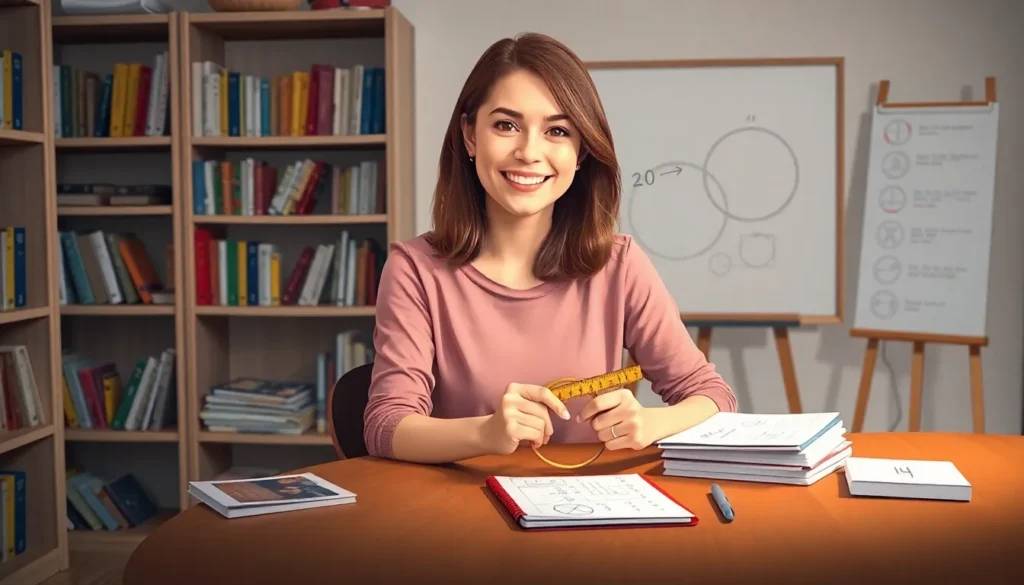Ever found yourself staring at a circle, wondering how on earth to figure out its diameter from the circumference? You’re not alone. It’s like trying to solve a mystery with only half the clues. But fear not! With a sprinkle of math magic and a dash of curiosity, calculating the diameter is easier than pie—literally.
In just a few simple steps, anyone can unlock the secrets hidden within those round shapes. Whether you’re a student trying to ace that math test or just someone who wants to impress at the next dinner party, knowing how to calculate diameter from circumference will make you the circle-savant of your social circle. So grab your measuring tape, and let’s dive into the world of circles together. Who knew geometry could be this much fun?
Table of Contents
ToggleUnderstanding Circumference and Diameter
Circumference and diameter are fundamental concepts in geometry related to circles. Grasping these definitions provides clarity for calculations involving circles.
Definition of Circumference
Circumference is the distance around a circle. It measures the perimeter of the circle and offers essential information about its size. Formulas exist to find circumference, with the most common one being C = πd, where C represents circumference and d indicates diameter. Another method uses the radius, expressed as C = 2πr, where r stands for radius. Understanding circumference enables individuals to make sense of circular objects in real-world applications.
Definition of Diameter
Diameter is the longest distance across a circle, passing through the center. It divides the circle into two equal halves and is essential for various calculations. The relationship between diameter and circumference follows the formula d = C/π, effectively allowing the extraction of diameter from known circumference values. Knowing the diameter can help determine other properties of circles, enhancing comprehension of geometry and its practical uses.
Formula for Calculating Diameter

Calculating the diameter from the circumference is straightforward with the right formula. The most commonly used formula is d = C/π.
Circumference to Diameter Formula
This formula expresses the relationship between circumference and diameter neatly. To find the diameter, divide the circumference by π, which is approximately 3.14. For instance, if the circumference measures 31.4 units, the diameter calculates to about 10 units. This method highlights how easily one can derive the diameter given the circumference. Accurate measurements rely on knowing the circumference first, making this formula vital for various applications in geometry.
Alternative Formulas
Additional formulas provide options for calculating diameter differently. The equation C = 2πr offers a method connecting diameter to radius. To determine diameter using radius, double the radius value, so d = 2r. For example, if the radius is 5 units, the diameter equals 10 units. Simplifying calculations can prove beneficial in various mathematical contexts, and utilizing both formulas enhances flexibility in problem-solving. These approaches ensure accurate assessments in real-world scenarios involving circular objects.
Step-by-Step Calculation
Calculating the diameter from the circumference involves a simple formula. Using this process makes it easy for anyone to understand the relationship between these two geometric elements.
Example Calculation
For example, if a circle’s circumference measures 31.4 units, you can find the diameter by applying the formula d = C/π. Dividing 31.4 by approximately 3.14 gives about 10 units for the diameter. This straightforward calculation illustrates how one can easily derive the diameter using the known circumference.
Common Mistakes to Avoid
Avoid common pitfalls to ensure accurate calculations. First, confusion often arises when people forget to use the correct value of π, which is approximately 3.14. Rounding errors can lead to inaccurate results, so maintaining precision is crucial. Another mistake involves incorrect assumptions about the diameter being directly equal to the circumference. Keep in mind that these two measures are related but not equal. Being aware of these traps can lead to a smoother calculation experience.
Real-Life Applications
Understanding how to calculate diameter from circumference has numerous real-life applications. This knowledge aids in various tasks, making many processes more efficient.
Practical Uses in Everyday Life
Circumference and diameter calculations play vital roles in everyday situations. For example, when determining the size of a circular table or pizza, knowing the diameter helps in budget and material planning. Cyclists benefit from these calculations to ensure tire pressure aligns with their wheels’ dimensions. Homeowners can accurately measure garden hoses or circular pools with this skill, ensuring proper fittings and adjustments.
Importance in Various Fields
In engineering, calculating diameter from circumference proves essential in designing machinery. Accurate measurements guarantee functional components, influencing performance and safety standards. Architects utilize these calculations to create aesthetically pleasing structures while adhering to safety regulations. Furthermore, in manufacturing, precise dimensions ensure quality control, leading to reduced waste and enhanced productivity.
Calculating the diameter from circumference opens up a world of understanding in geometry. By mastering the formula d = C/π, anyone can simplify their approach to circular measurements. This skill not only boosts confidence in math but also proves valuable in everyday scenarios.
From determining the size of a pizza to ensuring proper fittings for garden hoses, the ability to derive diameter enhances practical decision-making. Embracing these calculations allows individuals to navigate various fields like engineering and architecture with greater ease. With practice and awareness of common pitfalls, anyone can become proficient in this essential mathematical concept.





